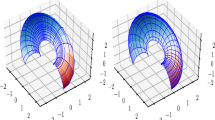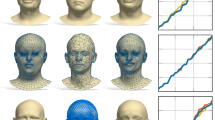Abstract
In this paper, we propose significant extensions to the “snake pedal” model, a powerful geometric shape modeling scheme introduced in (Vemuri and Guo, 1998). The extension allows the model to automatically cope with topological changes and for the first time, introduces the concept of a compact global shape into geometric active models. The ability to characterize global shape of an object using very few parameters facilitates shape learning and recognition. In this new modeling scheme, object shapes are represented using a parameterized function—called the generator—which accounts for the global shape of an object and the pedal curve (surface) of this global shape with respect to a geometric snake to represent any local detail. Traditionally, pedal curves (surfaces) are defined as the loci of the feet of perpendiculars to the tangents of the generator from a fixed point called the pedal point. Local shape control is achieved by introducing a set of pedal points—lying on a snake—for each point on the generator. The model dubbed as a “snake pedal” allows for interactive manipulation via forces applied to the snake. In this work, we replace the snake by a geometric snake and derive all the necessary mathematics for evolving the geometric snake when the snake pedal is assumed to evolve as a function of its curvature. Automatic topological changes of the model may be achieved by implementing the geometric snake in a level-set framework. We demonstrate the applicability of this modeling scheme via examples of shape recovery from a variety of 2D and 3D image data.
Similar content being viewed by others
Explore related subjects
Discover the latest articles, news and stories from top researchers in related subjects.References
Caselles, V., Catte, F., Coll, T., and Dibos, F. 1993. A geometric model for active contours in image processing. Numerische Mathematik, 66:1-31.
Caselles, V., Kimmel, R., and Sapiro, G. 1995. Geodesic active contours. In Fifth International Conference on Computer Vision, pp. 694-699.
Gray, A. 1993. Modern Differential Geometry of Curves and Surfaces. CRC Press, Boca Raton.
Kass, M., Witkin, A., and Terzopoulos, D. 1987. Snakes: A active contour models. Int. Journal of Computer Vision, 1:321-331.
Kichenassamy, S., Kumar, A., Olver, P., Tannenbaum, A., and Yezzi, A. 1995. Gradient flows and geometric active contour models. In Fifth International Conference on Computer Vision, pp. 810-815.
Kimmel, R., Amir, A., and Bruckstein, A.M. 1995. Finding shortest paths on surfaces using level sets propogation. IEEE Trans. on Pattern Analysis and Machine Intelligence, 17(6):635-640.
Leventon, M.E., Grimson, W.E.L., and Faugeras, O. 2000. Statistical shape influence in geodesic active contours. In Proc. of the IEEE Conference on Compu. Vision and Pattern Recognition (CVPR).
Lorigo, L.M., Faugeras, O., Grimson, W.E.L., Keriven, R., Kikinis, R., and Westin, C.F. 1999. Co-dimension 2 geodesic active contours for mra segmentation. In Proc. of the XVI Intl. Conf. on Info. Processing in Medical Imaging, pp. 126-139.
Ma, T. and Tagare, H. 1999. Consistency and stability of active contours with euclidean and non-euclidean arc lengths. IEEE Trans. on Image Processing, 8(11): 1549-1559.
Malladi, R., Sethian, J.A., and Vemuri, B.C. 1993. A topology independent shape modeling scheme. In SPIE Proc. on Geometric Methods in Computer Vision II, SPIE, Vol. 2031, pp. 246-256.
Malladi, R., Sethian, J.A., and Vemuri, B.C. 1995. Shape modeling with front propagation: A level set approach. IEEE Trans. Pattern Analysis and Machine Intelligence, 17(2):158-175.
Marc, P., Menet, S., and Medioni, G. 1990. B-snakes: Implementation and application to stereo. In IU Workshop, pp. 720-726.
Osher, S. and Sethian, J. 1988. Fronts propagating with curvature dependent speed: Algorithms based on Hamilton-Jacobi formulation. Journal of Computational Physics, 79:12-49.
Osher, S. and Shu, C.W. 1991. High-order essentially nonoscillatory schemes for Hamilton-Jacobi equations. SIAM J. Numerical Analysis, 28(4):907-922.
Paragios, N.K. and Deriche, R. 1998. A pde-based level-set approach for detection of moving objects. In Proc. of the IEEE Intl. Conf. on Compu. Vision, pp. 1139-1145.
Shah, J. 1996. A common framework for curve evolution, segmentation and anisotropic diffusion. In IEEE Conf. on Computer Vision and Pattern Recognition, San Francisco, CA.
Siddiqi, K., Lauziere, Y.B., Tanenbaum, A., and Zucker, S.W. 1998. Area and length minimizing flows for shape segmentation. IEEE Trans. on Image Processing, 7(3):433-443.
Siddiqi, K., Tanenbaum, A., and Zucker, S. 1998. Area and length minimizing flows for shape segmentation. IEEE Trans. on Image Processing, 7(3):433-443.
Tek, H. and Kimia, B.B. 1995. Image segmentation by reactiondiffusion bubbles. In Fifth International Conference on Computer Vision, Boston, MA.
ter Harr Romeny, B.M. (Ed.). 1994. Geometry-Driven Diffusion in Computer Vision. Computational Imaging and Vision, Kluwer Academic Publishers, The Netherlands.
Vemuri, B.C. and Guo, Y. 1998. Snake pedals: Geometric models with physics-based control. In Proc. of the IEEE International Conference on Computer Vision, Bombay, India, pp. 427-432.
Vemuri, B.C. and Guo, Y. 2000. Snake pedals: Compact and versatile geometric models with physics-based control. In IEEE Trans. on Pattern Analysis and Machine Intelligence, 22(5):445-459.
Vemuri, B.C. and Radisavljevic, A. 1994. Multiresolution stochastic hybrid shape models with fractal priors. In ACM Trans. on Graphics, pp. 177-207.
Wickert, J. 1996. Nonlinear diffusion in scale space: From the continuous to the discrete setting. In Proc. ICAOS'96: Images, Wavelets and PDE's, Berger, M.O. (Ed.), Springer, New York, Vol. 219, pp. 111-118.
Xu, C. and Prince, J. 1998. Snakes, shapes and gradient vector flow. IEEE Trans. on Image Processing, 7(3):359-369.
Yezzi, A., Tsai, A., and Wilsky, A. 1999. A statistical approach to snakes for bimodal and trimodal imagery. In Proc. of the IEEE Intl. Conf. on Compu. Vision, pp. 898-903.
Author information
Authors and Affiliations
Rights and permissions
About this article
Cite this article
Vemuri, B.C., Guo, Y. & Wang, Z. Deformable Pedal Curves and Surfaces: Hybrid Geometric Active Models for Shape Recovery. International Journal of Computer Vision 44, 137–155 (2001). https://doi.org/10.1023/A:1011897628647
Issue Date:
DOI: https://doi.org/10.1023/A:1011897628647




